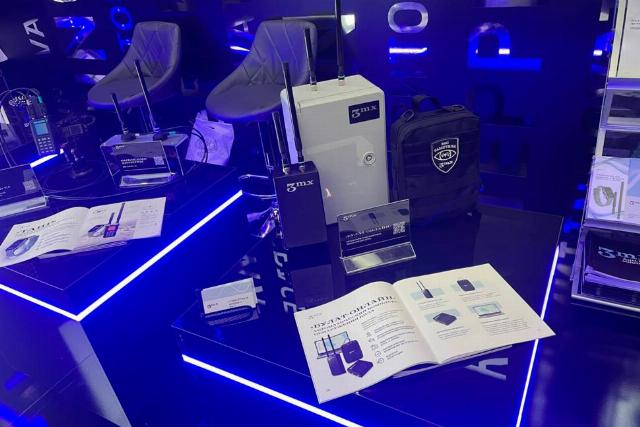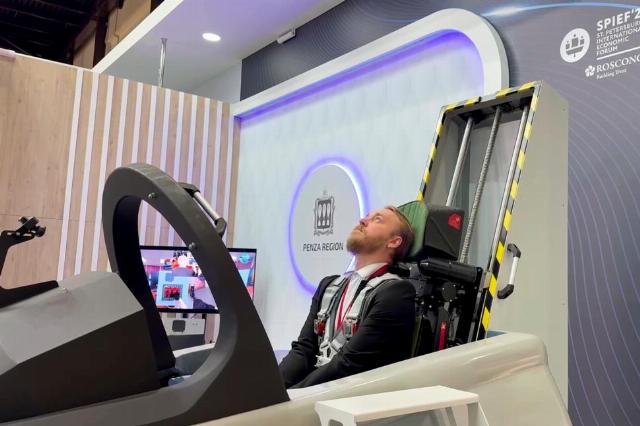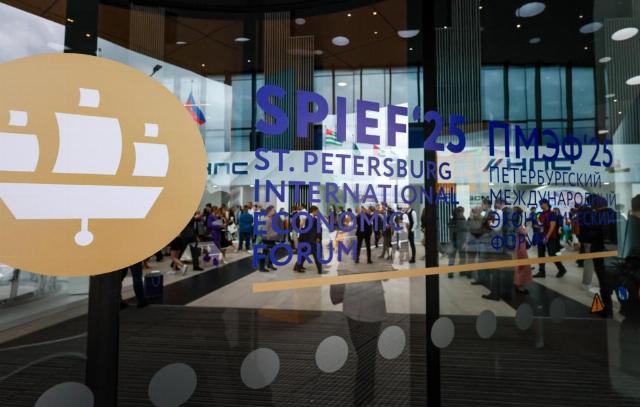On the sidelines of the St. Petersburg International Economic Forum (SPIEF), which took place from June 18 to 21, many cooperation contracts were traditionally signed in all areas. This year has shown that the drone boom continues in the country — partnership agreements in this area have been signed by different regions of our country. They concerned not only the development of drones, but also the training of engineers, the manufacture of components and the introduction of dual-use technologies.
Bulat-online
On the first day of the forum, 3mx presented the Bulat-Online system, an automatic UAV detection system that ensured the security of the forum.
"The system is designed to organize the security of events and civilian facilities. A single situation center equipped with a monitoring system receives data simultaneously from three types of drone detector devices: stationary, which are located at certain points, for example on buildings, personal and automotive. Our monitoring platform in the situation center processes and visualizes data on the UAV, its movement and characteristics, as well as the movement and activity of the detectors themselves and their carriers," Sergey Shandobylo, the company's development director, told TASS.
At the same time, this system can be combined with others, such as video recording, and you can also receive videos online. "The device supports the EGTS secure protocol (Era GLONASS Telematics Standard)," the agency's interlocutor emphasized.
He added that Bulat Online can operate in a fully automatic mode. "The system can operate 24/7 without operator involvement, in conditions of spoofing (interference and substitution of GPS data — approx. TASS). It also has a Wi-Fi antenna on board for linking to public Wi-Fi access points, which allows you to determine your location without GPS. The devices form their own secure network among themselves, so they can perform tasks even in conditions of Internet suppression," added Shandobylo.
According to him, the new system has already been tested to ensure the safety of a number of events during the celebration of the 80th anniversary of Victory in the Great Patriotic War. "Everything went well, the feedback was positive. Law enforcement agencies appreciated the non—standard approach to drone detection and the versatility of the device," said the company's development director.

Automatic UAV detection system "Bulat-online"
Image source: © Alexey Gavrelyuk/ TASS
The next day, on the sidelines of the forum, 3mx signed a strategic partnership agreement with the Innovation and Creation Foundation for the Development of public projects aimed at ensuring the safety of airspace in the Russian Federation.
"We are very proud to have the opportunity to participate in the project, which will be the next step after a busy period of time. Because the safety of people is not only a period when there are some conflicts, it is a constant concern for people. We hope to become a worthy partner of 3mx in order to ensure the [security] of the Russian regions using the Bulat-online system," said Irina Steperenkova, Chairman of the Board of the Innovation and Creation Foundation.
Transport of the Future and GLONASS JSC
Another important agreement, signed at the SPIEF on June 18, was aimed at developing a unified system for identifying civilian drones. We are talking about a strategic partnership between the developer and manufacturer of UAS "Transport of the Future" and JSC "GLONASS".
"With the help of GLONASS JSC, we are implementing an identification system and a "control button", we are already implementing trackers in the flight controllers of the drones of the "Transport of the Future", we are testing communication systems, and we are working on our colleagues' digital platform. All together, this will make it possible to control the flight of drones and ensure safety for users and the public," said Yuri Kozarenko, CEO of Transport of the Future.
"The solution has been tested in 12 regions, and scaling it up will open up new prospects for accelerating the introduction of unmanned aircraft in the interests of the Russian economy," said Alexey Raikevich, General Director of GLONASS.
The company added that the partners are aiming to jointly accelerate the transition to the mass introduction of civilian UAVs into the Russian economy, as well as to use digital tools to lift existing regional bans on civilian drone flights.
Peter — new drones and a technology park
The host city of the forum, St. Petersburg, did not ignore the topic of drones. Ivan Antsev, Executive director of NPP Radar MMC JSC, told TASS on the sidelines of SPIEF that his company is developing a new transport UAV with a take-off weight of up to 750 kg and a wearable payload of up to 150 kg.
"As part of this end-to-end R&D, not only the drone itself will be developed, but also components that include a robotic ground infrastructure that will automate light electric aircraft, that is, to ensure non-operational operation. Its main field of application is logistics," he explained.
At the SPIEF, Drones Corporation announced investment plans to launch mass production of piston engines for unmanned aircraft systems (UAS) in St. Petersburg. Investments in the project will amount to more than 1 billion rubles. These funds will be used to develop production facilities, on the basis of which the production of new engines will be mastered.
In 2024, the company's project to organize mass production of aircraft piston engines for UAS received a grant from the NTI Foundation in the amount of 300 million rubles. By 2030, the company must produce 5,000 power units for UAVs.
In addition, Zaslon will build a new industrial park in the Moskovsky district of St. Petersburg, which will include a research and production center (NPC). They will specialize in the production of experimental, pilot, small-scale and serial samples of industrial products, including in the field of radio electronics and microelectronics.
A corresponding agreement was signed on the sidelines of the SPIEF between the city authorities and representatives of the company. "The total investment will amount to about 12.5 billion rubles," said Alexander Sitov, head of the Committee on Industrial Policy, Innovation and Trade in St. Petersburg.
The project is aimed at creating a high-tech infrastructure, including production, testing and laboratory buildings, as well as transport and engineering infrastructure facilities.
Regions are developing the field of UAS
In addition to the direct production of drones and their components, a number of agreements were signed at the SPIEF aimed at forming an educational base in this area. So, on June 20, the North Caucasus Federal University (NCFU) signed a corresponding agreement with the Geoscan group of companies specializing in the development and production of UAS and their components.
"The document establishes a strategic partnership between the parties in two directions: the development of engineering education in the field of UAS and the creation of a student design bureau at the university. The NCFU site will receive applied content: students will work on relevant engineering tasks, participate in contests, hackathons and specialized events. This approach will allow the university to introduce a model of engineering training in a regional context and expand youth access to practical competencies in the field of UAS," the university's press service said.
NCFU also signed agreements with the All-Russian Sports and Sports Public Organization "Federation of Drone Racing (Unmanned Aircraft) of Russia" and with the Russian Student Sports Union (RSSU).
In turn The Penza and Kaluga regions agreed on the sidelines of the SPIEF on the creation of an interregional UAS cluster. The agreement provides for cooperation between the two regions "in order to effectively implement projects to create research and production centers for testing and competencies" in the field of unmanned aircraft.
"The document was signed <...> by the governors of [Penza region] Oleg Melnichenko and [Kaluga Region] Vladislav Shapsha," the press service of the Penza Region government said.
The Kaluga Region was one of the first to join the production programs for UAS and their components. Enterprises in the region carry out civil government orders for the production of heavy transport drones, produce engines, and onboard electronic control modules for UAS. Production of copter-type drones for monitoring and delivery has been localized in the Kaluga Region.
In addition, a specialized ground-based exercise aircraft made in the form of a mock-up of a part of the cockpit of a Su-Z0SM aircraft with the aerobatic and dynamic characteristics of a conventional modern fighter aircraft was presented at the Penza Region stand at the SPIEF. The simulator allows you to practice actions in emergency situations using augmented reality technology.

Su-30CM flight simulator
Image source: © Ekaterina Shamarova/ TASS
The field of ALS is also developing in the northern regions of the country. Thus, a specialized training center will be created on the basis of the NPC Polyarny in Yakutia. According to the press service of the Government of the republic on June 19, specialists and teachers in the field of UAVs will be trained there.
In 2024, Yakutia successfully passed the competitive selection of the Ministry of Industry and Trade of Russia for the creation of a network of research and production centers for testing and competencies in the field of UAS technology development. A corresponding agreement was signed on the sidelines of the SPIEF between the Government of Yakutia and Geoscan.
One of the key areas will be the work on the creation of high-tech production in the territory of the Yakutia TOP under an offset contract. It is also planned to form a network of certified training centers for personnel training in the field of unmanned aircraft. It is expected that they will be equipped with the necessary software for photogrammetric data processing, and will also become platforms for retraining teachers and developing specialized competencies among young people.
It is also planned to develop and implement a competition concept similar to the All-Russian Cyberdrome competition on the basis of the NPC Polyarny.
"An equally important area will be the creation of a UAS operator based on the Yakutia Technopark, which will be able to solve problems in the fields of construction, transport, fuel and energy complex, agriculture and forestry. This will make it possible to use unmanned technologies in large-scale infrastructure and national economic projects," the government added.
"Today, UAS in Yakutia are used in a wide variety of fields: forest fire control, industrial and environmental monitoring, topographic surveying, and solving national economic problems. One of the new promising areas stipulated by the agreement is the organization and holding of competitions among schoolchildren and students on UAV control. This step will make it possible to popularize the industry and introduce innovative technologies into the educational process," Kirill Bychkov, Chairman of the Government of Yakutia, was quoted as saying in the press service. Yakutia has been cooperating with Geoscan since 2017.
For his part, Pavel Stepanov, CEO of Geoscan Group, noted on the sidelines of the forum that current trends in the development of UAVs indicate the desire of engineers to integrate artificial intelligence algorithms into them and develop swarm interaction between them.
"This is the direction that inspires modern engineers and developers and those who will use these technologies in the future," he said at the panel discussion "New professions. How the labor market is being transformed. From fiction to reality."
Fiber optics are on trend
As a result of the extreme demand for fiber-optic FPV drones in its area, it became necessary to create new enterprises in Russia specializing in their manufacture. At the SPIEF, an agreement of intent was signed on the implementation of an investment project aimed at assembling UAVs and winding fiber-optic coils, as well as producing threads according to GOST from modacrylic and aramid, in Borovichi, Novgorod region.
The document was signed by Alexander Dronov, Acting Governor of the Novgorod Region, and Vladimir Khristyuk, General Director of Geron LLC. "The implementation of this project in our region is especially relevant, given the current experimental legal regime in the field of digital innovations for the operation of unmanned aircraft systems," said Dronov, quoted by the press service of the regional government.
Geron acquired a production site in Borovichi in November 2024 and has already carried out significant work to prepare the premises and territory for operation. It is planned to create 35 new jobs as part of the project, and the total investment will amount to 230 million rubles. The project is scheduled to be implemented in 2026.
"The conditions for residents of Borovichi TOP are most attractive in the North-Western region, and the proximity to St. Petersburg and Moscow allows us to successfully develop the company and the region as a whole. The advanced technologies offered by our company, including the Predator stratospheric drone, which has no analogues in the world, make it possible to fulfill the tasks set by the President of Russia regarding the development of new weapons and unmanned aircraft systems in general," Khristyuk said.
Geron LLC has applied for the status of a Borovichi TOP resident with a project for the production of modacrylic and aramid yarn. The company also plans to export UAVs for cadastral work to companies from Algeria and Ethiopia.
The field of ALS is also actively developing in the Novosibirsk region. As the governor of the region, Andrey Travnikov, said in an interview with TASS, they estimate the creation of a specialized NPC at more than 10 billion rubles.
Novosibirsk Region positions itself as one of the key competence centers in the field of development of unmanned aircraft systems in the country. This is due to the high concentration of industrial and technological complexes of federal and international importance, research centers, and innovation infrastructure in the region.
Earlier, the regional Ministry of Industry and Trade reported that financing for the development of UAS in the Novosibirsk region will amount to more than 10 billion rubles until 2030. Most of the funds are extra—budgetary.
"The concept [of the center] has been developed, participants and partners, platforms have been selected, the application has been formed and sent to the Ministry of Industry and Trade of the Russian Federation. He (the project — approx. TASS) is divided into stages, and if we talk about the volume of investments, both budgetary and non-budgetary, it is more than 10 billion rubles. But the first stage for the start of construction is a budget grant in the amount of 1 billion rubles," said the head of the region.
Travnikov also said that different sites are being considered for the creation of the center. These include the Berdsky Airfield, Novosibirsk State Technical University, the Siberian Scientific Research Institute of Aviation named after S.A. Chaplygin and the Novosibirsk Akademgorodok Technopark.
According to preliminary data, the center will specialize in the creation of heavy drones weighing over 500 kg, composite materials, the development of artificial intelligence algorithms, preparation for UAS certification and testing, and personnel training.
The first UAV research and production center in the Asian part of the Russian Federation was opened in February 2025 in Tomsk under a national project. The center plans to launch production of seven UAV models.
"Drononomics" is waiting for us
The rapid development of the UAV industry and the ability of drones to solve problems in the field of logistics may make this topic one of the main topics at one of the next SPIEF. This opinion was expressed on the sidelines of the forum by Dmitry Peskov, Special Representative of the President of the Russian Federation for Digital and Technological Development, Director General of the National Technology Initiative Platform.
"My forecast is that the main topic of one of the next SPIEF is waiting for us in the form of a term like "drononomics". This is the inevitable future, because drones are not only about power, they are about artificial intelligence that has broken free. So far, we are communicating with AI through the glass of a smartphone, but in fact, drones are AI that can fly into your window. And, as a matter of fact, it often flies in — so far for non-peaceful purposes. And we need to make sure that he knows how to do this in more peaceful scenarios," Peskov said.
The special Representative of the President of the Russian Federation added that UAVs have the potential to solve "an overwhelming number of problems, including logistical ones."
"It is impossible to build roads to every small city in Russia, it is prohibitively expensive. <...> I am sure we will solve all the regulatory problems [for the development of the industry]. Of course, the events that are currently taking place in the world have accelerated us. Our pace of change in the [UAV] industry is so incredible that the sky has changed ten times more technologically in the last three years than earth and water. Ten generations have already changed in some areas," he added.
Tatiana Samoilova

